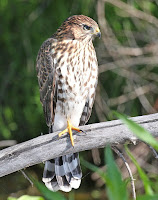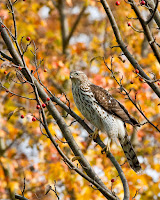COOPER'S HAWK
COOPER’S HAWK – (Accipiter cooperii) – (See images below)
DESCRIPTION: The Cooper’s Hawk adult is blue-grey on top with a black cap. Throat is white and finely cinnamon streaked. Underside is white with fine cinnamon bars. Tail is long and square and has three dark grey bars. Undertail has grey and whitish bars. Wing tips are rounded. First section of underwing looks same as breast. Rest of underwings are finely barred dark grey and whitish. Wing barring is darker on top. Legs are long and partly covered with feathers, and are yellow as well as the feet. Eyes are red, hooked bill is short and grey, but yellow at the base. Immature has a brown striated head and brown top parts, and white under parts with fine brown streaks on the throat and breast. Eyes are yellow. Sexes are similar, but females are markedly heavier than males. Bird length is about 38 cm (15 inches).
VOICE: https://www.xeno-canto.org/species/Accipiter-cooperii
NAME: The English name ‘Hawk’ would stem from ‘to have’, to seize or grasp. The name ‘Cooper’s was given to this bird to honour American naturalist William Cooper. Latin name ‘Accipiter’ means ‘to grasp’.
HABITAT: Woodlands, forest edges, also urban areas with tall trees.
DIET: Birds, small mammals, some reptiles and insects.
NESTING: Nest is built high in a tree, often on top of older nest. From two to six light blue eggs are laid, incubated by female. Chicks fed by female.
DISTRIBUTION: Breeds on both sides of Canada’s southern border, winters in Mexico. Can be observed in-between those regions during migration.
Distribution Map: https://en.wikipedia.org/wiki/Cooper%27s_hawk – /media/File:Accipiter_cooperii_map.svg
ON PEI: Does not breed on Prince Edward Island, sightings listed as ‘accidental’ so far. See note below on bird vagrancy.
CONSERVATION: Population appears stable, currently not at risk.
Vagrancy: In biology this means an animal going way outside its normal range. For birds, this can happen when there are storms and they get blown off course. On other times, the bird simply wanders in a different direction than usual. Here’s an article about vagrancy in birds.
SIMILAR SPECIES: Broad-winged Hawk, Sharp-shinned Hawk – Here’s an article to help distinguish the sharp-shinned hawk from the Cooper’s hawk.
REFERENCES: https://www.borealbirds.org/bird/coopers-hawk
https://www.mba-aom.ca/jsp/toc.jsp (Maritimes Breeding Bird Atlas)
https://hawkwatch.org/learn/factsheets/item/91-coopers-hawk
https://nature.mdc.mo.gov/discover-nature/field-guide/coopers-hawk (Missouri Department of Conservation)
http://fieldguide.mt.gov/speciesDetail.aspx?elcode=ABNKC12040 (Montana Field Guide)
https://animaldiversity.org/accounts/Accipiter_cooperii/ (University of Michigan)
https://txtbba.tamu.edu/species-accounts/harriss-hawk/ (Texas Breeding Bird Atlas)
https://birdatlas.mb.ca/accounts/speciesaccount.jsp?sp=COHA&lang=en (Manitoba Breeding Bird Atlas)
https://en.wikipedia.org/wiki/Cooper%27s_hawk
DESCRIPTION: The Cooper’s Hawk adult is blue-grey on top with a black cap. Throat is white and finely cinnamon streaked. Underside is white with fine cinnamon bars. Tail is long and square and has three dark grey bars. Undertail has grey and whitish bars. Wing tips are rounded. First section of underwing looks same as breast. Rest of underwings are finely barred dark grey and whitish. Wing barring is darker on top. Legs are long and partly covered with feathers, and are yellow as well as the feet. Eyes are red, hooked bill is short and grey, but yellow at the base. Immature has a brown striated head and brown top parts, and white under parts with fine brown streaks on the throat and breast. Eyes are yellow. Sexes are similar, but females are markedly heavier than males. Bird length is about 38 cm (15 inches).
VOICE: https://www.xeno-canto.org/species/Accipiter-cooperii
NAME: The English name ‘Hawk’ would stem from ‘to have’, to seize or grasp. The name ‘Cooper’s was given to this bird to honour American naturalist William Cooper. Latin name ‘Accipiter’ means ‘to grasp’.
HABITAT: Woodlands, forest edges, also urban areas with tall trees.
DIET: Birds, small mammals, some reptiles and insects.
NESTING: Nest is built high in a tree, often on top of older nest. From two to six light blue eggs are laid, incubated by female. Chicks fed by female.
DISTRIBUTION: Breeds on both sides of Canada’s southern border, winters in Mexico. Can be observed in-between those regions during migration.
Distribution Map: https://en.wikipedia.org/wiki/Cooper%27s_hawk – /media/File:Accipiter_cooperii_map.svg
ON PEI: Does not breed on Prince Edward Island, sightings listed as ‘accidental’ so far. See note below on bird vagrancy.
CONSERVATION: Population appears stable, currently not at risk.
Vagrancy: In biology this means an animal going way outside its normal range. For birds, this can happen when there are storms and they get blown off course. On other times, the bird simply wanders in a different direction than usual. Here’s an article about vagrancy in birds.
SIMILAR SPECIES: Broad-winged Hawk, Sharp-shinned Hawk – Here’s an article to help distinguish the sharp-shinned hawk from the Cooper’s hawk.
REFERENCES: https://www.borealbirds.org/bird/coopers-hawk
https://www.mba-aom.ca/jsp/toc.jsp (Maritimes Breeding Bird Atlas)
https://hawkwatch.org/learn/factsheets/item/91-coopers-hawk
https://nature.mdc.mo.gov/discover-nature/field-guide/coopers-hawk (Missouri Department of Conservation)
http://fieldguide.mt.gov/speciesDetail.aspx?elcode=ABNKC12040 (Montana Field Guide)
https://animaldiversity.org/accounts/Accipiter_cooperii/ (University of Michigan)
https://txtbba.tamu.edu/species-accounts/harriss-hawk/ (Texas Breeding Bird Atlas)
https://birdatlas.mb.ca/accounts/speciesaccount.jsp?sp=COHA&lang=en (Manitoba Breeding Bird Atlas)
https://en.wikipedia.org/wiki/Cooper%27s_hawk
 |
| Cooper's hawk, Alan Schmierer |
 |
| Cooper's hawk, Mdf |
 |
| Cooper's hawk will kill, by Sagamore66 |
 |
| Cooper's hawk immature, Dawn Huczek |
 |
| Cooper's hawk immature, by Ybou |